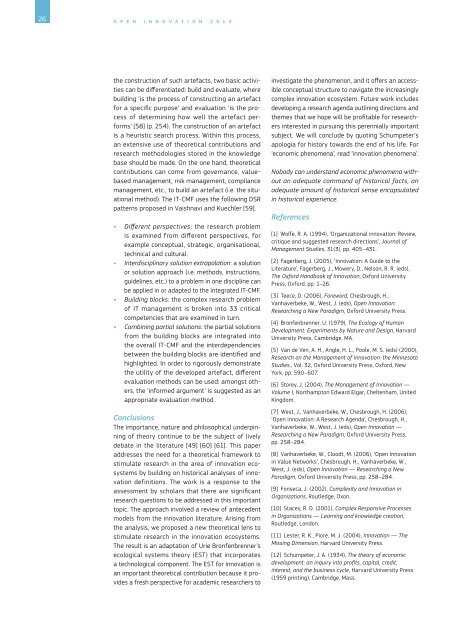Open Innovation 2.0 Yearbook 2013 - European Commission - Europa
Open Innovation 2.0 Yearbook 2013 - European Commission - Europa
Open Innovation 2.0 Yearbook 2013 - European Commission - Europa
Create successful ePaper yourself
Turn your PDF publications into a flip-book with our unique Google optimized e-Paper software.
26 O P E N I N N O V A T I O N 2 0 1 3<br />
the construction of such artefacts, two basic activities<br />
can be differentiated: build and evaluate, where<br />
building ‘is the process of constructing an artefact<br />
for a specific purpose’ and evaluation ‘is the process<br />
of determining how well the artefact performs’<br />
[58] (p. 254). The construction of an artefact<br />
is a heuristic search process. Within this process,<br />
an extensive use of theoretical contributions and<br />
research methodologies stored in the knowledge<br />
base should be made. On the one hand, theoretical<br />
contributions can come from governance, valuebased<br />
management, risk management, compliance<br />
management, etc., to build an artefact (i.e. the situational<br />
method). The IT-CMF uses the following DSR<br />
patterns proposed in Vaishnavi and Kuechler [59].<br />
• Different perspectives: the research problem<br />
is examined from different perspectives, for<br />
example conceptual, strategic, organisational,<br />
technical and cultural.<br />
• Interdisciplinary solution extrapolation: a solution<br />
or solution approach (i.e. methods, instructions,<br />
guidelines, etc.) to a problem in one discipline can<br />
be applied in or adapted to the integrated IT-CMF.<br />
• Building blocks: the complex research problem<br />
of IT management is broken into 33 critical<br />
competencies that are examined in turn.<br />
• Combining partial solutions: the partial solutions<br />
from the building blocks are integrated into<br />
the overall IT-CMF and the interdependencies<br />
between the building blocks are identified and<br />
highlighted. In order to rigorously demonstrate<br />
the utility of the developed artefact, different<br />
evaluation methods can be used: amongst others,<br />
the ‘informed argument’ is suggested as an<br />
appropriate evaluation method.<br />
Conclusions<br />
The importance, nature and philosophical underpinning<br />
of theory continue to be the subject of lively<br />
debate in the literature [49] [60] [61]. This paper<br />
addresses the need for a theoretical framework to<br />
stimulate research in the area of innovation ecosystems<br />
by building on historical analyses of innovation<br />
definitions. The work is a response to the<br />
assessment by scholars that there are significant<br />
research questions to be addressed in this important<br />
topic. The approach involved a review of antecedent<br />
models from the innovation literature. Arising from<br />
the analysis, we proposed a new theoretical lens to<br />
stimulate research in the innovation ecosystems.<br />
The result is an adaptation of Urie Bronfenbrenner’s<br />
ecological systems theory (EST) that incorporates<br />
a technological component. The EST for innovation is<br />
an important theoretical contribution because it provides<br />
a fresh perspective for academic researchers to<br />
investigate the phenomenon, and it offers an accessible<br />
conceptual structure to navigate the increasingly<br />
complex innovation ecosystem. Future work includes<br />
developing a research agenda outlining directions and<br />
themes that we hope will be profitable for researchers<br />
interested in pursuing this perennially important<br />
subject. We will conclude by quoting Schumpeter’s<br />
apologia for history towards the end of his life. For<br />
‘economic phenomena’, read ‘innovation phenomena’.<br />
Nobody can understand economic phenomena without<br />
an adequate command of historical facts, an<br />
adequate amount of historical sense encapsulated<br />
in historical experience.<br />
References<br />
[1] Wolfe, R. A. (1994), ‘Organizational innovation: Review,<br />
critique and suggested research directions’, Journal of<br />
Management Studies, 31(3), pp. 405–431.<br />
[2] Fagerberg, J. (2005), ‘<strong>Innovation</strong>: A Guide to the<br />
Literature’, Fagerberg, J., Mowery, D., Nelson, R. R. (eds),<br />
The Oxford Handbook of <strong>Innovation</strong>, Oxford University<br />
Press, Oxford. pp. 1–26.<br />
[3] Teece, D. (2006), Foreword, Chesbrough, H.,<br />
Vanhaverbeke, W., West, J. (eds), <strong>Open</strong> <strong>Innovation</strong>:<br />
Researching a New Paradigm, Oxford University Press.<br />
[4] Bronfenbrenner, U. (1979), The Ecology of Human<br />
Development: Experiments by Nature and Design, Harvard<br />
University Press, Cambridge, MA.<br />
[5] Van de Ven, A. H., Angle, H. L., Poole, M. S. (eds) (2000),<br />
Research on the Management of <strong>Innovation</strong>: the Minnesota<br />
Studies., Vol. 32, Oxford University Press, Oxford, New<br />
York, pp. 590–607.<br />
[6] Storey, J. (2004), The Management of <strong>Innovation</strong> —<br />
Volume I, Northampton Edward Elgar, Cheltenham, United<br />
Kingdom.<br />
[7] West, J., Vanhaverbeke, W., Chesbrough, H. (2006),<br />
‘<strong>Open</strong> <strong>Innovation</strong>: A Research Agenda’, Chesbrough, H.,<br />
Vanhaverbeke, W., West, J. (eds), <strong>Open</strong> <strong>Innovation</strong> —<br />
Researching a New Paradigm, Oxford University Press,<br />
pp. 258–284.<br />
[8] Vanhaverbeke, W., Cloodt, M. (2006), ‘<strong>Open</strong> <strong>Innovation</strong><br />
in Value Networks’, Chesbrough, H., Vanhaverbeke, W.,<br />
West, J. (eds), <strong>Open</strong> <strong>Innovation</strong> — Researching a New<br />
Paradigm, Oxford University Press, pp. 258–284.<br />
[9] Fonseca, J. (2002), Complexity and <strong>Innovation</strong> in<br />
Organizations, Routledge, Oxon.<br />
[10] Stacey, R. D. (2001), Complex Responsive Processes<br />
in Organizations — Learning and knowledge creation,<br />
Routledge, London.<br />
[11] Lester, R. K., Piore, M. J. (2004), <strong>Innovation</strong> — The<br />
Missing Dimension, Harvard University Press.<br />
[12] Schumpeter, J. A. (1934), The theory of economic<br />
development: an inquiry into profits, capital, credit,<br />
interest, and the business cycle, Harvard University Press<br />
(1959 printing), Cambridge, Mass.
















